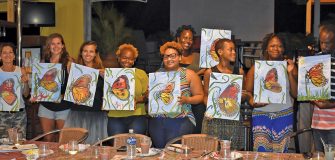Share
When last you smell a coal pit burning? Personally, I love the smell of a coal pit burning and even more now, that it is not so common. Perhaps it is because I grew up with them and now only when Velma Chung burns her coal pit do I smell a coal pit burning.
I kept smelling a coal pit and had no idea who was doing it, for I was so pleased to know that not all the excess wood from the hurricanes were not going to the dumpsite. Then I learned that it was Velma, I was surprised to know that of all the people, it was a woman burning coal.
I was at the side of the road, sometime around 6:30 am, trying to catch a ride to work when Velma’s sister Iona Dawson came up strolling in what we call hill clothes, which seemed a bit unusual to me. After cordial good mornings and small talk, I asked her, as if I was so sure, “You going to the ground?” She said, “No, I am going to help Velma haul out coal from her coal pit.” I was like, coal pit? Velma? So the pit I smelt when I was up by Selly is Velma’s,” I asked in amazement. She assured me that it was Velma’s and it is not her first coal pit either.
I decided I had to see this for myself. I made an appointment for the following week and I showed up late due to heavy rain and missed the opportunity. When I finally got time to go, she had already hauled all the coal and I was not too happy about that. However, with all the wood she had collected after last year’s hurricanes, Velma wasted no time setting up another coal pit. I decided I am not going to miss out this time, for the simple fact that I love culture and its preservation.
When it comes to culture Velma is one of the true patriots and active participants in making sure that Virgin Islands culture stays alive and strong. She is a farmer and was a winner of the best backyard garden. She is also a songwriter, singer, author, playwright, musician, and now a coal pit maker. She is a very good cook and baker of most of the traditional dishes and pastries such as Cassava Bread (Bong Bong), Ducuna, Fish and Fungi with Mayonnaise Sauce, Johnny Cakes (Fried Bread), Patties, Tarts and more. She also harvest the local Cocoa and grind it down to make cocoa tea, as well as local Tolomah. Not wanting to see anything go to waste, she also makes patch work and scrap rugs.
The time came and I made sure on was on time and prepared. When I got there, Velma was bushing her coal pit. Having experience with building coal pits with my father as a boy asking questions was like being rhetorical, so I simply asked Velma to share her experience and at the same time got a refresher course.
She explained that she too, like most, learned from her parents, but got a refresher course from Palette Cameron some years back. If you already have a coal pit bed as she does, the first thing she did was collect the wood and the fresher the wood the better it is. The better woods for making coals are the wood of the sea grape tree, the tamarind, the guava, the mango and the cashaw.
The last two coal pits Velma made were mainly from the mango trees in her backyard, and some sea grape trees, which she cut up for making the coal pit. This part of the job involved much of the labour, but she got help from her son Kievan and husband.
Thick planks of wood, what are referred to as runners, are placed on the bottom like a foundation so that the cut wood does not touch the ground after being placed on top in an orderly way, small, medium, then large. The coal pit should be flat like a bed after this process.
Then you would start to cover the wood with leaves. Velma at the time was using mango leaves and Ginny Grass, as there was a shortage of coconut branches after Hurricanes Irma and Maria. As much of the wood as possible was covered with these leaves. Then the soil was placed on top until there was a thick layer of soil. She used glavanised sheeting to hold in the dirt on both sides of the pit.
Based on the size of the coal pit, holes are left out to light the coal pit. In Velma’s coal pit, she only left one hole opened at the front. This is a crucial part of the whole task and had to have your attention. Then she lit the dry bush and leaves and after some time when she felt that the green wood had started to catch fire, she would close off the front opening with leaves and a good portion of soil. She would go all over the pit and cover it with soil to make sure that the pit was completely closed. She recalled times when the coal pit would burst.
“There were nights when I looked out and saw orange flames and had to wake up Kievan to help chink up the pit with more soil where it had burst,” She said with a grin.
Depending on the size of the pit, it would take a number of days before you could take further action. During that baking period, she constantly monitors the pit. If any smoke was leaking around the sides, you had to cover it up with soil so that the pit did not run away from her. “A coal pit is like a baby, it needs constant care and attention,” she explained.
Velma said that when the time comes to hauling out the coal she usually call in her sisters and other friends to assist. Her approximately 12ft long by 3ft high coal pit usually yields between 10 – 15 bags of coal. As custom would have it, she would sell the ‘big coal’ as it is called, and give the ‘fine coal’ to family, friends and neighbours.
Charcoal was once a big industry in the Virgin Islands, for it was domestically and exported to the neighbouring islands as the main fuel for cooking. It is only in the last few decades that this centuries old tradition has begun to die out. Velma is determined for as long as she has the strength to keep Virgin Islands culture alive. She extends the offer to demonstrate the process to schoolchildren territory wide.
Virgin Islands Life & Style Magazine thanks to Velma for keeping our culture alive. You go girl.



